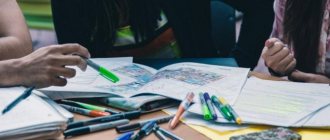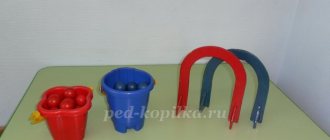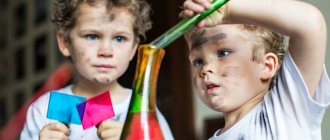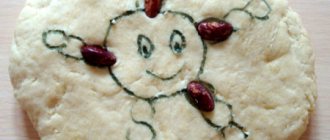Photo report “Creativity corner in an early age group”
Elena Gorbunova
Photo report “Creativity corner in an early age group”
Creating fine arts corner in a group children’s creative activity and promotes the emergence and development of independent artistic activity in children.
We bring to your attention the corner of creativity of the early age group No. 1 of MAOU "Educational Center 36" in Cherepovets.
At an early age, the development of children's creativity begins with simple scribbles. The kid doesn’t yet know what he is drawing, but he is fascinated by the process itself. At the same time, children enjoy looking at pictures in books, coloring, and learning to use stencils.
The main character of our corner is “The Cheerful Pencil”, who will always come to the rescue.
in the group ; children are offered various materials for creativity .
In the corner there are pencils , crayons, felt-tip pens, stamps, paints, plasticine, modeling clay, and various types of paper.
Children draw with great pleasure with sand and semolina.
Many different didactic games on the topic have been made.
Thank you for your attention!
Photo report on the work on the project “Teddy Bear” in the first early age group Dear guests of my page, dear friends! I suggest you look at the results obtained while working on the project. Our children,. Photo report. Autumn holiday in an early age group If the leaves on the trees have turned yellow, If the birds have flown to a distant land, If the sky is gloomy, if the rain is pouring, This time of year is called autumn. Photo report of the implementation of the pedagogical project “Easter” in an early age group. The most important task of today is to preserve the unity of Russia and the spiritual healing of society. A unique resource in solving this. Abstract of the educational activity for young children “It is snowing” in the second group of early age Synopsis of the educational activity for young children “It is snowing” Second group of early age Integration of educational areas. Goal: Creation.
What to plant in the garden in kindergarten?
From vegetable plants in the garden
grow: lettuce, spinach, radishes, onions, parsley, peas, cabbage (white, red, cauliflower, kohlrabi, carrots, turnips, beets, cucumbers, tomatoes, zucchini, pumpkin, squash, sorrel, celery, dill, rhubarb (perennial plant) ).
Interesting materials:
Sick leave at whose expense? Which brokerage or investment account should I open? What is BSO? How to decorate sandwiches with caviar? Household services, what do they include? What is a bear afraid of in the forest? Whose domain is ICU? Whose domain is us? Whose AvtoVAZ is it now? Someone's case?
Experimental activities at an early age
Dear friends, we are pleased to once again introduce you to Lyubov Vladimirovna Sukhanova, teacher at MBDOU “DSKV No. 46” in Bratsk, Irkutsk region. Today Lyubov Vladimirovna will kindly share her professional experience in organizing experimental activities at an early age. The article will be of interest to teachers of early age groups.
A short commentary on the article from Lyubov Vladimirovna:
“Kids love to experiment. This is explained by the fact that they are characterized by visual and effective thinking, and experimentation, like no other method, corresponds to these age-related characteristics. In preschool age it is the leader, and in the first three years it is practically the only way to understand the world.”
Useful reading...
Experimental activities at an early age
The desire to observe and experiment, to independently seek new information about the world around us are the most important features of normal child behavior. Research activity is a natural, biologically inherent state of a child. Every child is a researcher from birth. He is determined to understand the world. It is this internal desire for research that gives rise to exploratory behavior and creates the conditions for the child’s mental development to initially unfold in the process of self-development.
Many teachers and psychologists talk about the advantages of the experimentation method. But in reality, it is rarely used in the activities of young children. Despite many positive aspects, it has not yet become widespread.
Kids love to experiment. This is explained by the fact that they are characterized by visual and effective thinking, and experimentation, like no other method, corresponds to these age-related characteristics. In preschool age it is the leader, and in the first three years it is practically the only way to understand the world.
In the activity of experimentation, the child acts as a kind of researcher, independently influencing in various ways the objects and phenomena around him in order to more fully understand and master them. As knowledge about the object under study accumulates, the child gets the opportunity to set new, increasingly complex goals.
When deprived of the opportunity to get acquainted with the world around him through experimentation, the child’s mental development is inhibited.
In the process of experimentation, the youngest preschooler gets the opportunity to satisfy his inherent curiosity, to feel like a pioneer, a researcher.
The process of cognition is a creative process, and my task is to support and develop a child’s interest in research and discovery, and to create the necessary conditions for this.
Experience shows that elementary experimentation is already accessible to young children. They enjoy exploring objects. When choosing a method for introducing young children to the world around them, I chose experimental activities. Children should not only observe the objects they study, but also expose them to influences, modify them, and highlight new properties and qualities in them. A child should receive knowledge about a particular subject not as a bare fact, but as a result acquired in the process of searching and thinking.
To increase interest in experimental activities, I organized a laboratory where “Scientific Gnomes” conduct research. Children put on caps, turn into inquisitive characters and carry out joint experimental activities - making new scientific discoveries. Children believe in miracles and, at the level of fairy-tale reality, gain new rich knowledge and useful life experience.
The goal of the project is to create conditions for the development of children’s cognitive activity in the process of experimentation.
As a result of project activities, I try to solve the following problems:
1. Introduce children to methods of studying different objects (gradually connect all types of perception; help examine objects, highlighting their properties and qualities; encourage them to include hand movements in the process of getting to know the object, trace parts of the object with their hands, stroke them; perform actions of an experimental nature).
2. To form ideas about the properties and qualities of objects (teach to determine weight parameters, temperature qualities, material of manufacture; introduce the ability of magnets and obtaining intermediate shades when mixing paints, recognize objects by the sound they make, introduce sources of light and heat)
3. Develop analytical abilities (the ability to compare, correlate, group, establish the identity and difference of homogeneous objects according to a common property, establish physical laws).
4. Include children in practical cognitive activities of an experimental nature (observations, conversations, experiments) together with adults. Perform actions in accordance with the task, use modeling actions.
5. Stimulate cognitive activity, observation, curiosity.
6. Develop attention and memory, auditory differentiation, tactile sensations, fine motor skills.
7. Develop communication skills and proactive speech in the process of interaction.
I work with 3-year-old children in the amount of 7 people in the afternoon in joint activities.
The subject-spatial environment in the group is equipped with the material and equipment necessary to develop children’s cognitive interest in experimental activities:
Various vessels: plastic, glass, metal;
Technical materials: nuts, paper clips, bolts, nails.
Natural materials: pebbles, sawdust, feathers, sand.
Recycled material: wire, fabric, plastic, corks, caps.
Equipment: flashlights, electric lamp, rulers, syringes, tubes, sticks, containers, boxes.
Tools: magnets, magnifying glasses, mirrors, safety scissors.
Materials: paper, foil, fabric, sandpaper.
Items: small rubber and plastic balls, magnets, candles, wax pencils, wooden and metal spoons, buttons.
This project is aimed at bringing the child into contact with objects and materials. Elementary experiments with them make it possible to understand their properties, qualities, and capabilities; stimulate curiosity, a desire to learn more, and enrich them with vivid images of the world around them.
The experimental work is planned in stages, with subsequent complication. Initially, kids get acquainted with paper and fabric, learn to recognize things from these materials, and become familiar with the properties and quality characteristics. I suggest the children wash two dresses - one made of paper, the other made of fabric. Through practical actions, I bring the guys to the conclusion that paper is not intended for making clothes, it gets wet and breaks down in water, but the fabric retains its integrity. When conducting other experiments, children get acquainted with other characteristics of these materials: they learn that things are cut, wrinkled, absorbed, wet, stretched, torn.
In further research activities, children get acquainted with materials such as wood, metal, rubber, plastic, glass. They learn to recognize objects made from these materials and distinguish them by visual and tactile characteristics. During practical activities, children identify the surface structure of objects, their density, elasticity, thickness, flexibility, and thermal conductivity.
Children learn that the weight of objects depends on the material they are made of.
Thus, during the experimental activity “Masha and the Bear,” children group objects by weight (light – heavy) depending on the size of the fairy-tale character. Masha and the bear choose toys that each of them wants to take with them to their friends. There are several options for choosing toys:
• toys made of the same material, but different in size. I ask why Bear will take larger toys, and I check the children's answers by weighing the toys in their hands;
• toys are made of the same material, but some are hollow inside, while others are filled with sand. I ask what toys Masha will take and why;
• toys of the same size made of different materials. I find out who will carry what toy and why.
Then I invite the children to choose a “treat” in buckets that Masha and the Bear can carry, and I find out: how to find out which bucket Masha can carry and which the Bear can carry? We check the children’s assumptions by examining the contents of the buckets with them.
The “What Sounds” and “Sounds of Objects” experiments lead children to understand the causes of sound - the deliberate impact of a person on objects contributes to the occurrence of certain noise effects. Children learn to recognize objects by the sound they make and associate them with the sounds of nature and musical instruments.
The series of studies “Magic Rays” forms in children an idea of light sources: natural and man-made. I introduce children to ways of using objects: a candle, a flashlight, a lamp. In the course of practical activities, I come to the understanding that illumination depends on the power of the source.
Experimental activities such as Hocus Pocus and Magic Power introduce children to the power of magnets. Practical actions help to identify objects that interact with a magnet and lead to the conclusion that a magnet attracts only metal objects.
Thus, in the course of experimental activities, a young child learns to observe, think, compare, answer questions, establish cause-and-effect relationships, and follow safety rules.
The effectiveness of experimental activities is not possible without interaction with the family.
Consultations on “Experimental activities in kindergarten” and “Organization of children’s experimentation at home” contributed to increasing the information experience of parents. And the use of modern technologies (showing the presentation “Children’s Experimentation”, booklet “Young Researchers”) contributed to the emergence of interest in research activities at home.
Parents are actively interacting and information is currently being exchanged via email to create a World of Discovery photo album. I offered parents files of game-experiments for experimenting at home, and as feedback I receive photographs of the experimental activities carried out at home. There is a desire for further interaction.
Summing up my work, I came to the conclusion that by encouraging children’s curiosity, quenching the thirst for knowledge of little “whys” and by directing their active motor activity, we contribute to the development of cognitive activity, enriching children’s ideas about the environment in the process of experimental activities.
Literature:
- Approximate general education program for preschool education “From birth to school”, edited by N.E. Veraxes; M, Mosaic - Synthesis, 2014
- “Organization of experimental activities for children 2-7 years old, Thematic planning, recommendations, lesson notes” Authors - compilers E. A. Martynova, I. M. Suchkova Volgograd: Teacher, 2011.
- Tugusheva G. P. Chistyakova A. E. “Experimental activities of preschool children” SP: CHILDHOOD - PRESS, 2007




